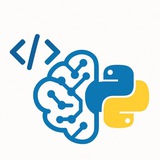url_shortener (1).py
585 B
Some source code related to some Python projects for beginners
✅ More ♥️♥️ = more posts
@CodeProgrammer ♥️
✅ More ♥️♥️ = more posts
@CodeProgrammer ♥️
❤32👍11
The Data Science and Python channel is for researchers and advanced programmers
Subscribe: t.me/DataScienceT
Subscribe: t.me/DataScienceT
Telegram
Data Science | Machine Learning with Python for Researchers
Admin: @HusseinSheikho
The Data Science and Python channel is for researchers and advanced programmers
Buy ads: https://telega.io/c/dataScienceT
The Data Science and Python channel is for researchers and advanced programmers
Buy ads: https://telega.io/c/dataScienceT
❤🔥5👍2
This is all you need to train a typical image classifier using TensorFlow! 🚀
Let's break it down step-by-step and see what's happening!
✅ More ♥️♥️ = more posts
@CodeProgrammer ♥️
Let's break it down step-by-step and see what's happening!
✅ More ♥️♥️ = more posts
@CodeProgrammer ♥️
❤🔥12❤8👍3
Building a Convolutional Neural Network in PyTorch
https://machinelearningmastery.com/building-a-convolutional-neural-network-in-pytorch/
✅ More ♥️♥️ = more posts
@CodeProgrammer ♥️
Don't Forget join to another channel
https://t.me/DataScienceT
https://machinelearningmastery.com/building-a-convolutional-neural-network-in-pytorch/
✅ More ♥️♥️ = more posts
@CodeProgrammer ♥️
Don't Forget join to another channel
https://t.me/DataScienceT
❤9👍3
How do Transformers work?
All the Transformer models mentioned above (GPT, BERT, BART, T5, etc.) have been trained as language models. This means they have been trained on large amounts of raw text in a self-supervised fashion. Self-supervised learning is a type of training in which the objective is automatically computed from the inputs of the model. That means that humans are not needed to label the data!
This type of model develops a statistical understanding of the language it has been trained on, but it’s not very useful for specific practical tasks. Because of this, the general pretrained model then goes through a process called transfer learning. During this process, the model is fine-tuned in a supervised way — that is, using human-annotated labels — on a given task
🔗 Read More
🌸 https://t.me/DataScienceT
All the Transformer models mentioned above (GPT, BERT, BART, T5, etc.) have been trained as language models. This means they have been trained on large amounts of raw text in a self-supervised fashion. Self-supervised learning is a type of training in which the objective is automatically computed from the inputs of the model. That means that humans are not needed to label the data!
This type of model develops a statistical understanding of the language it has been trained on, but it’s not very useful for specific practical tasks. Because of this, the general pretrained model then goes through a process called transfer learning. During this process, the model is fine-tuned in a supervised way — that is, using human-annotated labels — on a given task
🔗 Read More
🌸 https://t.me/DataScienceT
❤5👍2❤🔥1
